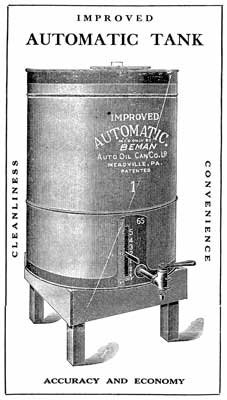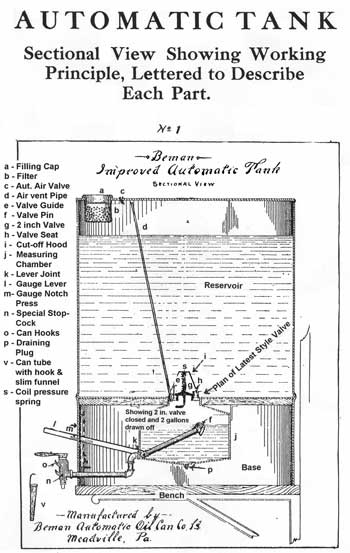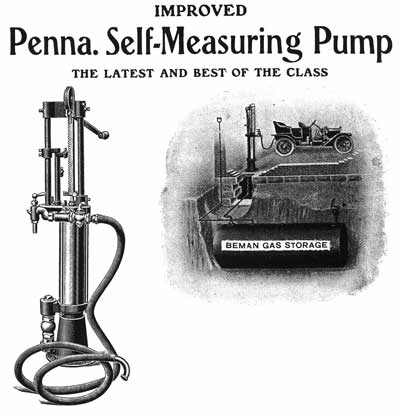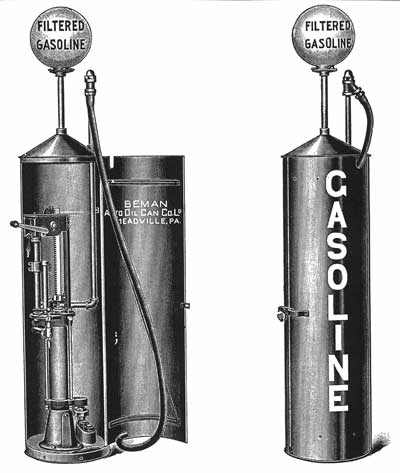|
|
Beman Automatic Gasoline Tank
The Beman Automatic Oil Can Co. was established by Henry C. Beman as a Limited Partnership in 1892 in Meadville, Pennsylvania. Their first product, the Original Beman Automatic Can, was named for the particular spout design that would allow the contents, say kerosene, to run into a lamp and when the lamp was full, it would cease flowing automatically. They manufactured this type of high grade can in several sizes, one, three and five gallon. Beman also produced a line of containers and pumps among which figured a self-measuring vinegar cabinet (it had a graduated glass tube), a carboy acid pump and a delivery can.
The delivery can came principally into use in the late 1890’s for carrying oil or gasoline and was made in three and five gallon sizes. The Beman delivery can was air-tight and had a fitted 3/4 inch nozzle-shaped spout with patented vent inside so that the gasoline would run in a large solid stream. Beman also made a pneumatic oil can, and a Golden Automatic Oil Can which they declared was “the most perfect of all oil cans”.
 |
This Improved Automatic Tank in Beman’s 1911 catalog presumably replaced an older one which was sold around 1900. Beman was one of the very first manufacturers of gasoline dispensers.
|
Beman soon began to make gasoline measuring and dispensing tanks and developed a popular line of these beginning late 1890’s and, by 1911, were putting out new improved automatic tanks and cabinets which the company stated were patented in five countries. They were sold around the world and appeared in many of the first gasoline stations, curbside and otherwise. In fact, Beman claimed that it was the world’s first automatic gasoline dispenser and became the company’s biggest product (Getchell, 1967). The gasoline contained in the Beman devices was usually drawn into cans at first and then transferred to the customer’s gas tank, later directly by hose into the vehicle’s tank. The Beman tanks operated by a lever and the tank had scaled notches up to five gallons.
 |
This sectional view of the Beman automatic dispensing tank is after the cut in their 1911 catalog.
|
|
|
 |
This Beman 120 gallon gasoline cabinet tank (a curb side device) comes with an air pump and hose to deliver gasoline to any height car. The delivery hose is not shown. The cabinet box was red. This model was deemed an improvement on the Improved Automatic Tank and was put on the market shortly after 1911. Not in the 1911 catalog.
|
|
Beman also made a hand operated forced rotary pump and check valve, a rotary barrel pump, underground storage tanks including the boiler-type, cellar storage tanks, etc. All of these devices and especially the Improved Automatic Tank and the Self-Measuring Curb Gasoline Station saw considerable demand consistent with the growing popularity of internal combustion engines. The Beman Automatic Oil Can Co. products figured greatly in the growing gasoline dispensing business. The company lasted basically into the WW II years but wasn’t officially liquidated until 1967 when the long abandoned buildings were declared fire hazards and torn down (Shaffer, 1988). Records show that tanks were sold to some major oil companies up to 1943, but that sales had tapered off in the late 1930’s and Beman wasn‘t keeping up with the competition. The contents of the buildings were there in such quantity that an auction was conducted in 1967. Shaffer (1988) writes that the buildings were left “as if the employees were coming back to work the next day, with gas lamps and pot-bellied stoves intact, and tools out on workbenches and tables”. Getchell (1967) had a firsthand look at the factory which had laid idle for many years. She wrote that hundreds of completed tanks, other products, raw materials, tools, etc. still crowded the plant.
 |
The Penna. Self-Measuring Pump shown here is the precursor of the modern upright gas pump. The gas was held in underground storage tanks, also made by Beman. The company stated that …“it is the peer of all self-measuring pumps.” It was made sometime after 1911.
|
|
|
 |
This model of the Beman Self-Measuring Curb Gasoline Station pump begins to take on the familiar look of the early upright pumps and even has a crown. The company states that …”Nothing better than this Curb Outfit is made”. It was probably manufactured in the 19teens.
|
|
At its peak, the company employed 45 people and additionally had a large, roving group of salesmen, many of whom were in Canada and South America. General agents had Beman products in their stores in large cities. A really unusual pay system was used in the plant: wages and raises were often on the order of fractions of a cent: 5 cents raised to 5 5/16 cents per hour, 6 2/3 cents, 7 1/2 cents and finally 9 1/6 cents per hour (Getchell, 1967). The work force included a lot of young men as noted in old photographs. They certainly learned their fractions while working for Beman. In 1900 the highest paid worker earned 20 cents a hour.
|





